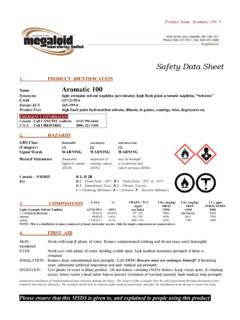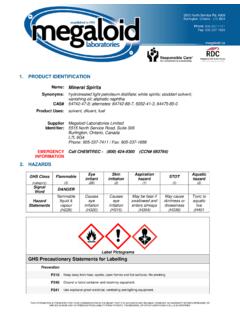Transcription of Safety Data Sheet - Megaloid
1 Product Name: Radiator Antifreeze Please ensure that this msds is given to, and explained to people using this product. 1 Safety data Sheet 1. PRODUCT INDENTIFICATION Name Radiator Antifreeze Synonyms Ethylene Glycol blend with proprietary anticorrosion salts CAS# 107 21 1* Product Uses motor vehicle antifreeze 2. HAZARDS Quick Guide: delayed toxicity(kidneydamage) potentially deadly on ingestion rodent teratogen Canada WHMIS D 2A Key: B 2 Flash Point <38 o C, B 3 Flash Point >38 o C & <93 o C D 1 Immediately Toxic, D 2 Chronic Toxicity C Oxidising Substance, E Corrosive, F Reactive Substance HMIS Health 2, Fire 1, Reactivity 0 Key: 0=minimal, 1=slight, 2=moderate, 3=serious, 4=severe 3. COMPOSITION % TWAEV / TLV mg/m 3 LD50 (mg/kg) ORAL LD50 (mg/kg) SKIN LC50 ppm INHALATION Ethylene Glycol 95 97%* 40 / 100 1650 9500 10,900 Water (CAS# 7732 18 5) 1 3%* none 90,000 not toxic not toxic *Concentration varies depending on the quantity and type of additives present.
2 These additives do not change the hazard classification of ethylene glycol 4. FIRST AID SKIN: Wash with plenty of water. Remove contaminated clothing and do not reuse until thoroughly laundered. EYES: Wash eyes with plenty of water, holding eyelids open. Seek medical assistance promptly if there is irritation. INHALATION: Remove from contaminated area promptly. CAUTION: Rescuer must not endanger himself! If breathing stops, administer artificial respiration and seek medical aid promptly. INGESTION: Give plenty of water to dilute product. Do not induce vomiting (NOTE below). Keep victim quiet. If vomiting occurs, lower victim s head below hips to prevent inhalation of vomited material. Seek medical help promptly. Inadvertent inhalation of vomited material may seriously damage the lungs.
3 The danger of this is greater than the risk of poisoning through absorption of this relatively low toxicity substance. The stomach should only be emptied under medical supervision, and after the installation of an airway to protect the lungs. NOTE TO DOCTOR:Following gastric lavage, oral ethanol and calcium gluconate help to reduce toxicity. If kidney function is normal, administer 4 litres of water daily to speed glycol excretion. If renal function is poor, dialysis should be used to speed glycol elimination. 5. FIRE FIGHTING & FLAMMABILITY Flash Point 111 o C / 232 o F (closed cup) Autoignition Temperature 398 o C / 748 o F Flammable Limits 22% Combustion Products carbon monoxide, nitrogen oxides, smoke, part oxidised hydrocarbon fragments Fire Fighting Precautions water fog or water spray firefighters must wear SCBA Static Charge Accumulation cannot accumulate a static charge on agitation or pumpingProduct Name: Radiator Antifreeze Please ensure that this msds is given to, and explained to people using this product.
4 2 6. ACCIDENTAL RELEASE MEASURES Leak Precaution dyke to control spillage and prevent environmental contamination Handling Spill ventilate contaminated area recover free liquid with suitable pumps absorb residue on an inert sorbent, sweep, shovel & store in closed containers for recycling or disposal WARNING: Depending on the surface, spilled product may be very slippery! 7. HANDLING & STORAGE Store in a cool, dry environment, away from sources of ignition, heat and oxidising agents. This product absorbs moisture from the air. Ensure that containers are tightly sealed. Bulk storage tanks should have moisture traps on their vents. Avoid breathing product vapour/mist. Use with adequate ventilation. Never cut, drill, weld or grind on or near this container.
5 Avoid contact with skin and wash work clothes frequently. An eye bath and Safety shower must be available near the workplace. WARNING: This product has a sweet taste. It is attractive for pets and children to drink. Ensure that spills are dealt with promptly to avoid inadvertent poisoning. 8. EXPOSURE CONTROL & PERSONAL PROTECTION OntarioCEV 40ppm / 100mg/m 3 ACGIH TLV C 40ppm / 100mg/m 3 OSHA PEL C 20ppm / 50mg/m 3 STEL (lowest listed) not listed Ventilation mechanical ventilation may be required to control airborne titre depending on handling procedures Hands nitrile or Viton gloves recommended other types may also protect consult supplier to confirm suitability Eyes Safety glasses with side shields always protect the eyes Clothing no special protective clothing required 9.
6 PHYSICAL PROPERTIES Odour & Appearance clear, viscous, fluorescent green*, hygroscopic, odourless liquid Odour Threshold none odourless (any odour indicates an impure product) Vapour Pressure / (20 o C / 68 o F) Evaporation Rate (Butyl Acetate = 1) below not considered volatile Vapour Density (air = 1) Boiling Range 158 o C / 317 o F** Freezing Point 20 o C / 3 o F** Specific Gravity ** (20/20 o C) Water Solubility complete Also soluble in lower alcohols, ethers, esters, ketones poorly soluble in hydrocarbons & chlorinated HCs Viscosity 21centipoise (20 o C / 68 o F) pH none (does not liberate hydrogen ions when dissolved) Conversion Factor 1ppm = 3 Molecular Weight 62grams per mole ethylene glycol only *Colour is added to this product other colours are possible.
7 **NOTE: Depending on the additive package, more or less water may beadded to the product. This may alter some of the physical Name: Radiator Antifreeze Please ensure that this msds is given to, and explained to people using this product. 3 10. REACTIVITY Dangerously Reactive With strong oxidising agents, perchloric acid, strong alkalis Also Reactive With strong acids Stability stable will not polymerize Decomposes in Presence of not known Decomposition Products none apart from Hazardous Combustion Products Sensitive to Mechanical Impact no 11. TOXICITY Effects, Acute Exposure Skin Contact no effect Skin Absorption slight no toxic effects likely by this route Eye Contact no effect Inhalation mist becomes irritating above127mg/m 3 intolerable above 240mg/m 3 inhalation is unlikely under industrial conditions due to low vapour pressure & elevated viscosity Ingestion ethylene glycol is an alcohol producing similar intoxication/depression symptoms high doses may cause convulsions & coma survival may befollowed by renal failureafter 3 days & possible death.
8 NOTE: Mammals metabolise EG into oxalic acid. The renal crystallisation of oxalic acid is responsible for renal failure & EC s lethality. Effects, Chronic Exposure General prolonged absorption may cause vision to deteriorate & damage kidneys Sensitising not a sensitiser in humans or animals very fewhuman cases reported Carcinogen/Tumorigen not considered a carcinogen in humans or animals tumorigen in rodents receiving high but sub lethal oral doses not an expected route of industrial exposure Reproductive Effect teratogen in rodents given high but sub lethal oral doses developmental abnormalities reported in children of mothers exposed to EG ðylene glycol monomethyl ether (a higher level of exposure than likely in Canada) Mutagen no known effect on humans or animals Synergistic With not known LD50 (oral) 1650 & 2000mg/kg (cat) 2725, 4700 5000mg/kg (rat), 5500mg/kg (mouse & dog)
9 , 6610mg/kg (guinea pig) LD50 (skin) 9530mg/kg (rabbit) LC50 (inhalation) 2725mg/m 3 (rat) NOTE:LD50 & LC50 test data vary widely between species. Relevance to human toxicity should not be assumed. 12. ECOLOGICAL INFORMATION Bioaccumulation cannot bioaccumulate biological life 3 5 hours Biodegradation degrades readily and rapidly in the presence of oxygen biodegradation essentially complete in 1 4 days Abiotic Degradation reacts with atmospheric hydroxyl radicals its estimated life in air is 50hours Mobility in soil, water water soluble moves readily in soil &water Aquatic Toxicity LC50 (Fish, 96hr) >10,000mg/litre (Lepomis macrochirus), 40,760mg/litre (Oncorhynchus mykiss), 49,000 57,000mg/litre (Pimephales promelas), 16,000mg/litre (Poecilia reticulata) EC50 (Crustacea, 48hr) >20,000mg/litre (Artemia salina), 41,000 57,600mg/litre (Daphnia magna) EC50 (Alg ) 6500 7500 & 24,000mg/litre (Selenastrum capricornutum), EC50 (Bacteria)
10 10,000mg/litre ( domestic sewage sludge ), 35,000mg/litre (Paramecium caudatum), 621mg/litre (Photobacterium phosphoreum), 10,000mg/litre (Pseudomonas putida) NOTE: Non mammalian species metabolise ethylene glycol differently from mammals. Its toxicity to non mammalians is very low. NOTE: The inorganic salts which act as corrosion inhibitors in this product do not biodegrade and are not toxic to aquatic Name: Radiator Antifreeze Please ensure that this msds is given to, and explained to people using this product. 4 13. DISPOSAL Waste Disposal do not flush to sewer, recycle solvent if possible, may be incinerated in approved facility after mixing with a suitable flammable waste Containers Drums should be reused. Recondition and pressure test by a licensed reconditioner prior to re use.

